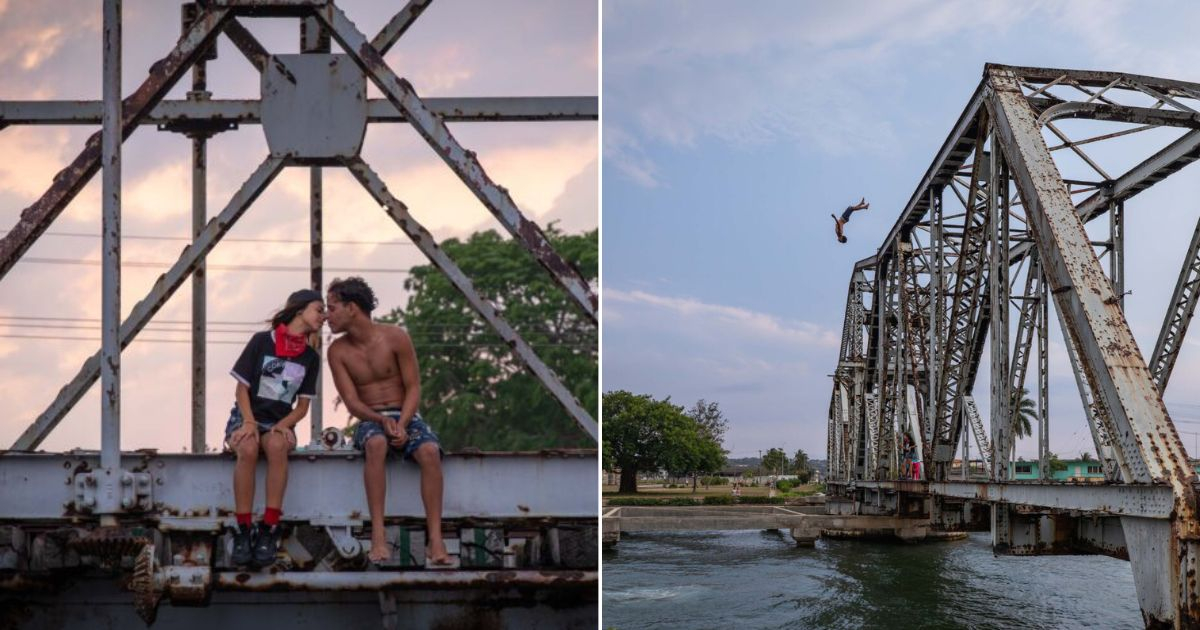The rotating bridge in Matanzas, a historical piece of steel architecture spanning the San Juan River, continues to serve as a backdrop for romantic encounters, bold promises, and decisions that defy both logic and safety. This long-standing structure, having withstood neglect and the passage of time, recently hosted a story of love laced with elements of danger.
According to the official newspaper Girón, a young couple chose this iconic bridge as a sanctuary amidst the scarcity of recreational options. With no movies or plans, they wandered aimlessly until they reached the point where river and iron meet. It was there, amidst silence and gazes, that he posed the question, “What if I jump?” And without further ado, he leaped into the water from above, a gesture she perceived as a wordless declaration. The scene, rich in symbolism, conveyed an underlying message: true love sometimes takes a leap of faith, relying on the belief that the other person will be there to catch you.
However, this act is not new and forms part of a risky tradition in the province. Jumping from bridges is a common practice among children and young people in Matanzas, yet it remains fraught with danger. The structures, worn down by years of decay and neglect, could potentially be the setting for tragic consequences stemming from carelessness. While the scene may inspire poetry and metaphors, many agree that raising awareness of the dangers associated with such actions is crucial: love may be blind, but caution should never be ignored.
A Historic Landmark with Engineering Marvel and Tourism Potential
Perhaps by 2025, Matanzas' renowned rotating bridge will once again pivot on its axis, standing as a living testament to past engineering achievements and a symbol of the city. This was announced by Leonel Pérez Orozco, Master Conservator of Matanzas, during a session of the Matanceridad Tertulia held last year at the provincial Uneac headquarters. According to the specialist, as reported by Girón, the viaduct will undergo a technical inspection by experts from Matanzas and Havana, with its restoration hinging on the findings of this evaluation.
Originally inaugurated on April 8, 1904, after being transported from the United States in disassembled pieces, the bridge measures approximately 70 meters in length. It was erected over the San Juan River, about 50 meters from its mouth. The original wooden base, which supported trains laden with sugar for decades, was replaced in 1981 with reinforced concrete pilings. The turning mechanism relies on gear wheels powered by a motor made in Philadelphia, initially run on magneto batteries and later on electricity. The rotation took one minute and 40 seconds, and the mechanisms needed to be operated at least once a week to prevent deterioration from rust. However, the system has been inactive for over twenty years, with the last rotation achieved manually by two railway workers using a lever to slowly align it between the neighborhoods of Matanzas and Pueblo Nuevo.
The rotating bridge in Matanzas is not only a unique piece in Cuba but also belongs to a now-rare typology of structures worldwide. Similar ones exist in Egypt (such as the El Ferdam, the longest over the Suez Canal), Uruguay (Carmelo Bridge), and Argentina (Puente de la Mujer). In Spain, these types of viaducts were common in the past, although many have been replaced. Unlike modern bascule or swinging bridges, Matanzas’ bridge retains a dual functionality: allowing rail and vehicular traffic while also enabling the passage of vessels. Its restoration would not only have heritage value but also enhance its appeal as a tourist attraction, bolstering Cuba’s Athens as a hub of cultural and living history.
In June, a Cuban elderly couple was photographed strolling hand in hand through the streets of Havana, capturing the admiration of thousands on social media with their tenderness and shared gestures. The scene, shared across digital platforms, served as a reminder of enduring love, the kind that survives the test of time and daily challenges, clinging to small acts like walking together under the Havana sun.
Months later, a reunion story moved many: a Cuban returned to the island after a two-year absence, surprising his partner in what became a viral moment. The tears, embrace, and emotion captured on video revealed the depth of bonds that remain unbroken despite distance and time, separated by migration circumstances so common in the current Cuban reality.
Just a month ago, another unexpected display of love made headlines when a Cuban proposed to his pregnant girlfriend expecting twins during a family celebration. The gesture, full of tenderness and hope, was recorded in a video that spread across social media, highlighting values of commitment and family, even amid economic and social crises.
These stories, like the one on the rotating bridge of Matanzas, reflect various forms of love in contemporary Cuba: from silent devotion to the most daring public gestures.
Exploring the Legacy and Future of Matanzas' Rotating Bridge
What makes the rotating bridge in Matanzas unique?
The rotating bridge in Matanzas is unique due to its historical significance, engineering design, and dual functionality, allowing both rail and vehicle traffic while permitting the passage of boats.
Why is there a need to raise awareness about jumping from the bridge?
Raising awareness is crucial because jumping from the bridge is a dangerous activity that can lead to serious injuries or fatalities, especially given the bridge's deteriorated condition.
How could the restoration of the bridge benefit Matanzas?
Restoring the bridge would not only preserve its historical value but also boost tourism, enhancing Matanzas as a cultural and historical destination.
